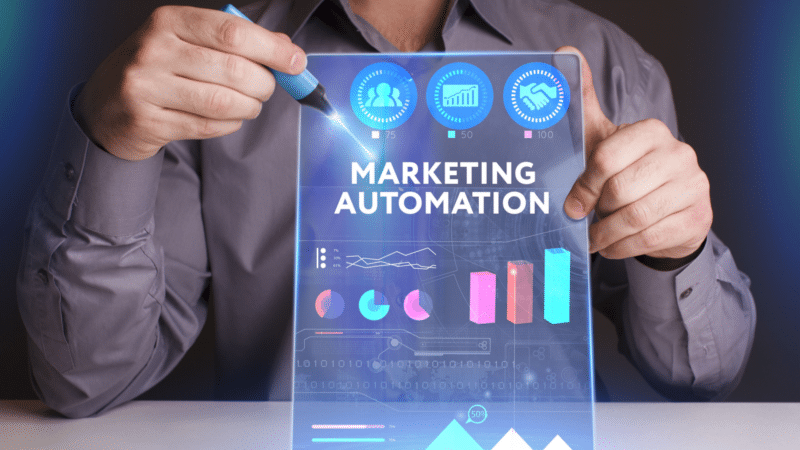ALL BUSINESS
COMIDA
DIRECTORIES
ENTERTAINMENT
FINER THINGS
FREE CREATOR TOOLS
HEALTH
MARKETPLACE
MEMBER's ONLY
MONEY MATTER$
MOTIVATIONAL
NEWS & WEATHER
TECHNOLOGIA
TV NETWORKS
VIDEOS
VOTE USA 2026/2028
INVESTOR RELATIONS
ALL BUSINESS
COMIDA
DIRECTORIES
ENTERTAINMENT
FINER THINGS
FREE CREATOR TOOLS
HEALTH
MARKETPLACE
MEMBER's ONLY
MONEY MATTER$
MOTIVATIONAL
NEWS & WEATHER
TECHNOLOGIA
TV NETWORKS
VIDEOS
VOTE USA 2026/2028
INVESTOR RELATIONS
Posted by - Latinos MediaSyndication -
on - April 22, 2023 -
Filed in - Marketing -
-
456 Views - 0 Comments - 0 Likes - 0 Reviews

Marketing automation is quite literally that — the automation of specific marketing tasks so that they are accomplished more speedily and efficiently, creating the opportunity to deliver personalized and relevant messages at scale. It can also deliver cost reductions as well as a better customer experience.
Below, we will introduce some of the basic concepts around marketing automation and ways you can get the most out of it.
Table of contents
Marketing automation platforms (MAPs) help automate activities across various marketing channels. The goal is to put repetitive tasks such as sending emails, posting on social media pages and managing data on autopilot.
Marketing departments use marketing automation to ensure their campaigns generate desired outcomes rapidly and efficiently. Employees can focus on thinking through higher-level problems when automation is working correctly. It can take some time to set up initially, but the results can significantly impact your business once it is up and running.
Marketing automation is often associated with email marketing. After all, marketing automation began with IBM’s Unica email platform in the early 1990s.
It’s useful to have an automated system for sending emails at scale to selected audiences or triggering emails in response to users’ certain actions (cart abandonment, for example). But using marketing automation only for emails can result in a disjointed customer experience. Thus, marketers must also consider its use across other channels too.
Key benefits of marketing automationIn addition to efficiency, marketing automation has several key benefits for marketing organizations:
Savings in time, energy and moneyMarketing automation is responsible for increasing productivity among sales by 14.5% and reducing overhead in marketing initiatives by 12.2%. Intuitive marketing automation tools can give marketers their time back to invest in other initiatives and activities that boost a company’s bottom line in other ways.
Better targeting of audiencesA marketing automation platform that works for you will allow you to target your audience and monitor behaviors on your campaigns. Tracking real-time data and monitoring engagement allows you to capitalize on personalized communication across multiple channels. Consistent and relevant communication to your target audience results in major ROI and a boost in customer loyalty.
Embed a seamless omnichannel experienceRemember, marketing automation takes over all the repetitive tasks when done correctly. When this happens, you can craft a seamless and personalized customer experience. Targeted emails, pre-filled forms based on user data and anticipating customer behaviors help to ensure your customers receive the same service each time.
How does marketing automation work?Marketing automation tools and platforms may have specific nuances to how they function, but at a high level, they automate workflows. They help us remove all the individualized sticky notes on our desks with reminders and put those reminders into a cadence that automatically gets done with minimal human involvement.
At a basic level, marketing automation campaigns will send content to a list of contacts based on a specified behavior or predetermined criteria to get them to take a certain action.
For example, let’s say you’re doing your last webinar before the end of the year, and you want to get some new leads into the pipeline to start January off strong. What would you typically do with marketing automation doing its part?
As you can see, you did nothing except craft the content and inject it into the automation tool. The tool did the rest of the work until the sales call, for which people generally prefer speaking with people.
Marketing automation best practicesThere are plenty of marketing automation tools available. The first rule of thumb is to do your research and see which one would be best for your business and which will help you reach the goals you’re trying to achieve the best. Here are a few other best practices to follow.
Understand the journey of your buyersFor a marketing automation tool to benefit you, you must understand the journey of your target audience.
If you know this information, you will find it easy to craft a workflow that works.
Ensure your content is relevant, engaging and consistentYour audience is likely already bombarded by endless content, with most of it not being so good. How do you intend to cut through the noise? Test your content before feeding it to the automation tool.
You want to produce what people actually want, not what you think they want. Once you have found what your audience finds relevant and engaging, deliver it to them consistently.
Avoid lengthy processesDelight your customers but don’t bog them down with lengthy forms and overbearing popups. In each piece of content, focus on one asset, one opportunity and one call to action. The “keep it simple” rule of thumb applies here.
Popular marketing automation vendorsMarketing automation software is very widely used by marketing automations. There are many solutions on the market.
Some specialize in B2B marketing, and as noted above, there are variations in the capabilities offered by each platform. Among the best-known and most popular are:
A good marketing automation system keeps marketing to your target audience simple and consistent while being less time-consuming and cost-effective.
For best results, follow the key points in this article and allow marketing automation to improve communication with your target audience.
Here’s some further reading:
The post Why we care about marketing automation appeared first on MarTech.

